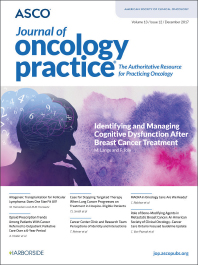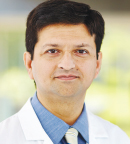
Many patients with follicular lymphoma relapse within 2 years of initial therapy, and for a number of these individuals, hematopoietic cell transplantation is a good treatment option. Transplant, however, both autologous and allogeneic, is vastly underutilized in these patients, according to Mehdi Hamadani, MD, Professor of Medicine at the Medical College of Wisconsin, who recently discussed transplant as a treatment option in the Journal of Oncology Practice.1 The ASCO Post asked Dr. Hamadani to share some thoughts about transplant for follicular lymphoma.
‘Heated Controversy’ in Hematology
What is the general thinking about hematopoietic cell transplant in follicular lymphoma today?
The role and timing of transplant, whether autologous (auto-transplant) or allogeneic (allo-transplant), have been a matter of heated controversy in the field of hematology for a number of years. In the past 5 to 10 years, many new nontransplant treatments have been approved, including novel monoclonal antibodies and targeted agents. These agents, either alone or in combination with conventional chemotherapies, are active in relapsed, refractory follicular lymphoma. So my coauthor, Mary Horowitz, MD, of the Center for International Blood and Marrow Transplant Research (CIBMTR) in Milwaukee, and I thought it was time to reappraise the role of transplant in light of these newer treatments.
Cost-Effectiveness
These new agents are very expensive. From a financial perspective, how does transplant compare with those treatments?
Transplant can be a cost-effective option, but I say this with the caveat that there are not a lot of contemporary data regarding the cost-effectiveness of transplant for follicular lymphoma relative to other treatments. With that limitation in mind, two drugs were recently approved: idelalisib (Zydelig) and copanlisib (Aliqopa). The average wholesale price of these two drugs does not include the so-called total cost of care associated with either agent (eg, charges for office visits, laboratory testing, radiographic imaging, and management of therapy-related complications).
For transplant, the cost varies vastly across state lines and according to the insurance provider of the patient as well as the contracts between transplant centers and insurance providers. Generally, the cost ranges from about $35,000 to $250,000, with the higher end associated with allo-transplant, non-Medicare/Medicaid payers, and possibly U.S. states with higher costs of living.
Transplant Eligibility and Use
Are there other advantages to transplant as well?
Absolutely! “Newer” agent is not synonymous with “curative” or “better-tolerated” agent. Most novel agents are associated with significant toxicities, and there are no conclusive data that responses provided by these agents are more durable than historically seen with transplantation.
The qualifier to this view is that transplant only applies to patients who are fit enough and young enough to receive it. The median age for transplant is late 50s for allo-transplant and mid-60s for auto-transplant. So transplant candidates are slightly younger, and may be more physically fit, than the average patient who is not considered for transplant. Moreover, for patients to receive a transplant, they must show evidence of chemosensitive disease (at least for auto-transplant). Thus, patient fitness and chemosensitivity are the deciding factors in determining transplant eligibility.
How common, or uncommon, is transplant among patients with follicular lymphoma?
The CIBMTR estimates that among patients with follicular lymphoma who are potential transplant candidates, fewer than 5% actually undergo transplantation. This amounts to about 150 to 200 auto-transplants a year in this country. For comparison, consider diffuse large B-cell lymphoma, which is only slightly more common than follicular lymphoma but accounts for about 1,200 auto-transplants in the United States every year. Transplant is massively underutilized in follicular lymphoma, even among otherwise healthy, young, and fit patients. We hope our article might help change that.
Barriers to Transplant in Follicular Lymphoma
What are some of the barriers to transplant for patients with follicular lymphoma?
The main barrier is lack of patient referral to transplant centers. There is no denying that the aforementioned newer agents are active in follicular lymphoma, but no large prospective studies show the durability of responses with these agents can rival mature data with auto-transplant. Data from the CIBMTR show, for example, that 35% to 40% of patients with follicular lymphoma are free of disease progression 10 years after auto-transplant. Patients up to age 70 with a reasonable performance status and chemotherapy-sensitive disease should be referred for auto-transplant after failing to respond to two to three lines of therapy. In more heavily pretreated patients, allo-transplant is still a curative option. In our recent study, relapse rates were less than 20%, and progression-free survival was between 70% and 80% following allo-transplant.2
Donor availability used to be a main barrier to allo-transplant. In the past 5 years, our group and others have shown that transplant using haploidentical (or half-matched) related donors (often a sibling or child) is probably equally safe when compared with matched unrelated donor transplant. In the vast majority of patients, therefore, a donor is available for allo-transplant, and this is no longer a barrier.
Allo-Transplant vs Auto-Transplant
All things being equal, which transplant type—allo-transplant or auto-transplant—is the preferred strategy?
My mantra is one size does not fit all patients, but there are some considerations. Generally speaking, early use of auto-transplant should be considered a standard treatment option for high-risk patients who experience early failure (up to 2 years) of chemoimmunotherapy. Allo-transplant is best reserved for medically fit patients with heavily pretreated disease, persistent marrow involvement, refractory but low-bulk disease, and for those who fail to mobilize stem cells for auto-transplant. Allo-transplant is also a reasonable option for patients with disease progression after auto-transplant.

Transplant is massively underutilized in follicular lymphoma, even among otherwise healthy, young, and fit patients.— Mehdi Hamadani, MD
Tweet this quote
We conducted an important study in a very high–risk subgroup of patients who had failed treatment within 2 years of their first chemoimmunotherapy. We compared patients with early treatment failure who had never received auto-transplant (contributed by the National LymphoCare study in collaboration with Drs. Carla -Casulo and Jonathan Friedberg) with those who did receive auto-transplant within 1 year of treatment failure; we found that auto-transplant conferred an overall survival benefit, 73% vs 60% (P = .02).3
More recently, in high-risk patients failing to respond to rituximab (Rituxan) within 2 years, we have asked whether auto-transplant is the best option or whether sibling donor transplant or matched unrelated donor transplant is the modality of choice. The results of this study were published in Cancer,4 but the bottom line is that outcomes were similar between auto-transplant and sibling donor transplant, whereas matched unrelated donor transplants underperformed. Therefore, my recommendation is that in such high-risk patients, auto-transplant and sibling donor allogeneic transplant are both good options.
How do you choose between those two transplant options?
One argument for auto-transplant first is that you can potentially achieve durable disease control with a low risk of treatment-related mortality; and, if the patient relapses, you can perform a donor transplant. The reverse—offering a donor transplant first and then an auto-transplant—is obviously not feasible.
I think auto-transplant is a reasonable first step, especially for patients who have had only two to three prior therapies and excellent chemosensitivity and also for those who prefer minimal interruption in their lifestyle, have a poor performance status, and lack the necessary family support. Allo-transplant can be deferred to a later point in time.
However, in a very young, fit patient who has a sibling donor, and who has failed to respond to several lines of chemotherapy or is no longer responding to chemotherapy, allo-transplant is the only known curative treatment, and that would be my first choice in this case.
Advances on the Horizon
What’s the most exciting next step for transplant in follicular lymphoma?
We eagerly await a genomic/clinical prognostic model that can direct both risk stratification and clinical decision-making to guide patient selection for transplantation. There is a lot of enthusiasm in the field for gene-modified chimeric antigen receptor (CAR) T-cell therapies. Among the lymphomas, CAR T-cell therapy is currently approved only for diffuse large B-cell lymphoma, but we think it’s just a matter of time before it comes to follicular lymphoma as well. The word of caution is that, in aggressive lymphomas, although a subset of patients achieves long remission with CAR T cells, early relapse (within the first 3–6 months) is common and represents a major clinical problem.
In addition, CAR T-cell therapy is a potentially very expensive therapy. Although no one to my knowledge really knows the actual cost of administering these agents in the real world, consider the cost to procure just the immune effector cell product is more than $400,000. The overall cost of delivery and care would be staggering.
Message to Hematologists
What’s your message to hematologists regarding transplant in patients with follicular lymphoma?
Follicular lymphoma is an indolent disease in the vast majority of patients, but there is a subset with a very poor prognosis: those who fail to respond to front-line chemoimmunotherapy within 2 years. This is a group for whom transplant may provide durable disease control, and an early transplant consultation is warranted. ■
DISCLOSURE: Dr. Hamadani has received research support from Takeda, Spectrum Inc, and Otsuka; is on the speakers bureau of Sanofi; is a consultant for Pharmacyclics and MedImmune; and is on the data safety monitoring board for Cellerant.
REFERENCES
1. Hamadani M, Horowitz MM: Allogeneic transplantation for follicular lymphoma. J Oncol Pract 13:798-806, 2017.
2. Epperla N, Hamadani M, Ahn KW, et al: Survival of lymphoma patients experiencing relapse or progression after an allogeneic hematopoietic cell transplantation. Biol Blood Marrow Transplant 24:983-988, 2018.
3. Casulo C, Friedberg JW, Ahn KW, et al: Autologous transplantation is associated with improved overall survival in follicular lymphoma patients experiencing early therapy failure after frontline chemo-immunotherapy. Biol Blood Marrow Transplant 23:S46-S47, 2017.
4. Smith SM, Godfrey J, Ahn KW, et al: Autologous transplantation versus allogeneic transplantation in patients with follicular lymphoma experiencing early treatment failure. Cancer. April 12, 2018 (early release online).

